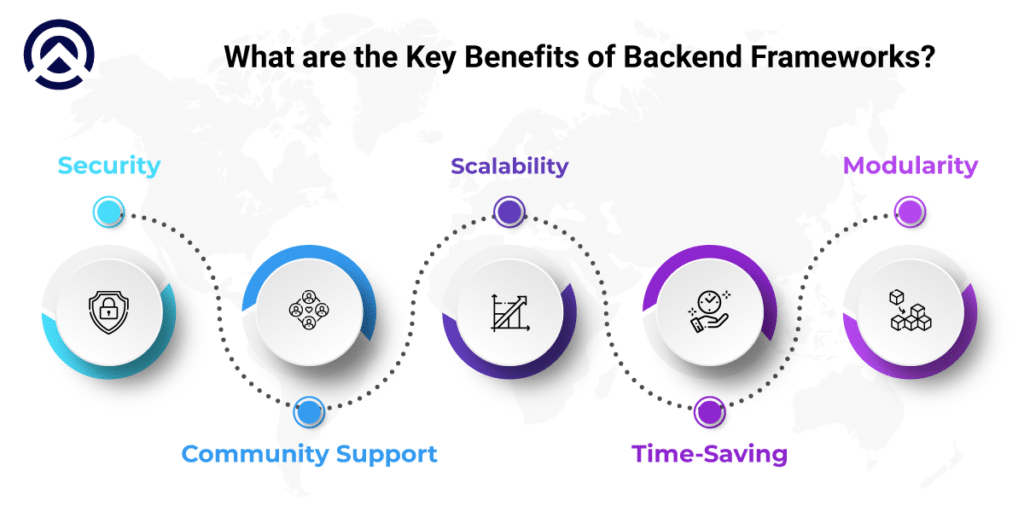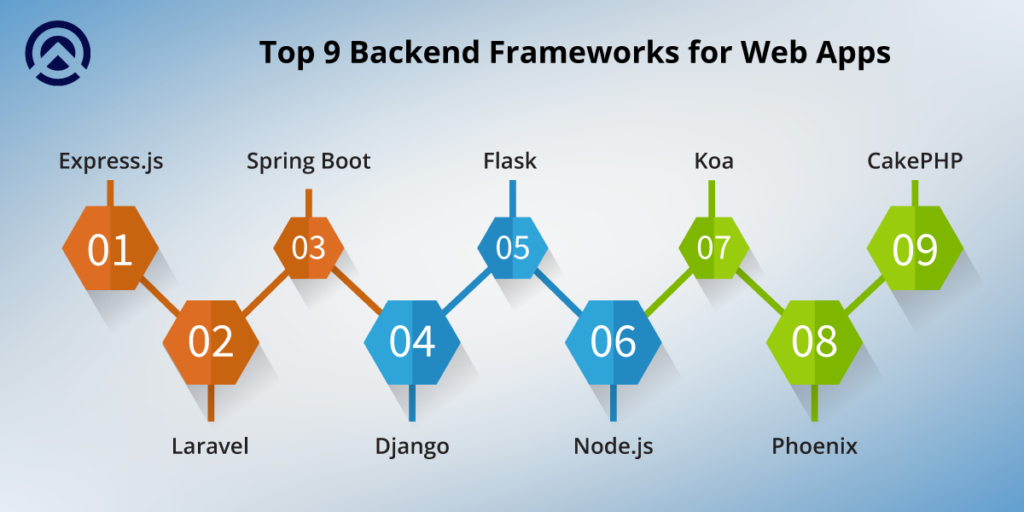Top 9 Backend Frameworks for Web App Development in 2024
In recent years, technology manifested at a huge level for developing advanced business solutions. Although, the use of technology also supported businesses in gaining various competitive advantages. From the developer’s perspective also it can be analyzed that the optimum use of the backend frameworks allowed them to fetch results in seconds.
Before moving forward, first, let’s move to understanding about the market size of web apps. According to the official report published by Emergen Research – the market size of progressive web applications was valued at $ 1.13 billion in the year 2019. It is estimated that this market will be reached at a whopping figure of $ 10.44 billion by the year 2027. As per the research, this market will grow at a CAGR of 31.9%.
Companies are eager to make changes in their current technologies so that they can bring new tech ideas to life. Now, a question can arise in your mind: what are the new and best backend frameworks for developing web apps?
In this blog, we’ll bring up the discussion for the top 9 most popular backend frameworks that are used for web app development. Read this blog till the end to get the knowledge about the latest backend frameworks which will help you to develop your tech solutions at a faster pace.
What are Backend Frameworks (Overview)?
Backend technology helps the developers develop logic to run a specific set of programs. If you want to develop any feature in your web apps then the role of backend operations is highly crucial. Developers will write a specific set of programs that will run the code. Backend frameworks provide the undetected magic which enables an application to function as expected even when it is invisible to the end user.
Backend frameworks, often known as “server-side frameworks,” supply you with more control over the tasks that your app or website does. On the other hand, the front end, commonly referred to as the client side, explains what individuals see when they use an internet site or program.
Frontend languages of programming and technologies manage every aspect of a software application that is visible to the user, including the way controls are organized, the colors, animations, etc.
What are the Key Benefits of Backend Frameworks?
Each backend framework incorporates a different set of benefits. Currently, we’re covering the discussion about the key benefits of backend frameworks in general.

1. Security
The optimum use of backend frameworks offers the security of operations in various ways – such as: they ensure easy data encryption, validation and user authentication.
2. Scalability
Frameworks which are present in the backend are generally flexible. The higher flexibility of frameworks helps the developers to quickly scale their applications and develop high-performing apps in an effective manner.
3. Modularity
To make the job of the developer’s work easy, backend frameworks allow developers to break down complex application code into different manageable modules. At the time of making web apps
4. Community Support
Whenever any developer faces an issue in running a code or any other problem then the availability of robust community support helps them to overcome the issue as early as possible.
5. Time-Saving
Frameworks incorporate pre-built components and libraries which are used to develop quick code-based applications. With the help of pre-built components developers can quickly scale up their project growth in an efficient manner.
Top 9 Backend Frameworks for Web Apps
Now, let’s begin the discussion related to the top 9 backend frameworks for web apps that’ll help you to develop fascinating web apps. Currently, there are different frameworks that developers incorporate but we’ve figured out the top 9 frameworks that will make your job easier.

1. Express.js
Express is a node web application that provides a wide range of web and mobile applications. The optimum use of Express.js while building single-page, multipage and hybrid web apps.
From the developer’s perspective, there are diverse types of HTTP demands however with the use of express.js, you can take advantage of the different types of HTTP requests.
In reality, many developers consider Express as a perfect choice for developing and exposing APIs that can be used to communicate with server applications. Moreover, you can hire affordable developers for enterprise web development.
2. Laravel
With the help of Laravel, developers can effectively ease common tasks during web projects – such as: routing functions, caching, authentication, etc. When developers do not want to sacrifice application functionality then Laravel is a perfect choice among developers.
Apart from this, you will be astonished to know that Laravel is also a free and open-source PHP-based web framework. The entire source code of Laravel is hosted on GitHub. It is exclusively licensed under MIT License.
3. Spring Boot
It is a popular Java-based framework used for building stand-alone, production-grade applications. It is a part of the larger Spring ecosystem, which provides a comprehensive set of tools and libraries for Java developers. Spring Boot aims to simplify the development process by providing opinionated defaults and conventions, allowing developers to quickly set up and configure applications.
One of the key features of Spring Boot is its ability to embed a web server, such as Tomcat or Jetty, directly into the application. This eliminates the need for external deployment and configuration, making it easier to create self-contained, runnable JAR files.
Spring Boot offers a wide range of built-in features and modules, such as auto-configuration, dependency injection, and seamless integration with popular databases, messaging systems, and security frameworks.
4. Django
Django is a high-level Python web framework that enables rapid development and clean design. It follows the Model-View-Controller (MVC) architectural pattern, emphasizing the reusability and modularity of components. Django’s main goal is to simplify the creation of complex web applications by providing a batteries-included framework with sensible defaults and powerful features.
One of the notable features of Django is its built-in Object-Relational Mapping (ORM) system. This allows developers to define database models using Python classes, eliminating the need to write SQL queries manually.
5. Flask
Flask is a lightweight and flexible Python web framework that focuses on simplicity and extensibility. It is often referred to as a microframework because it provides only the essentials for web development, giving developers the freedom to choose and integrate additional libraries as needed.
Unlike Django, Flask does not enforce a specific directory structure or include a full-fledged ORM system. Instead, it provides a solid foundation for building web applications by offering features such as URL routing, request handling, and template rendering.
6. Node.js
JavaScript code in Node.js runs in a single thread, thus it can only handle one task at once. However, the package, which supports I/O tasks like reading files from a disc or executing network requests, provides hidden threads through the multithreaded nature of Node.js itself.
Node.js supports asynchronous methods that enable your code to make I/O requests without disrupting the main thread through the usage of hidden threads. Node.js features hidden threads, yet one can’t offload CPU-intensive actions like complex computations, image expansion, or video compression utilizing them.
Although, for the node js backend framework you can hire the best node js developers. In order to minimize the cost of operations you should give preference to remote developers for the node backend framework.
7. Koa
Koa.js is a backend framework that is considered an open-source, flexible web framework. It is also considered as highly robust for web applications and APIs. not only this, but it also helps in improving error management with the optimum use of async functions.
The entire Koa.js is based upon ES6 generators that imply it can be written by using KOA.js with just fewer callbacks. There are the following features of KOA.js, such as:
- It is highly modern & futuristic.
- It incorporates small footprints.
- It supports better error-handling functions.
- It is effectively used as a context object.
After reading the above benefits of Koa.js may be that you are eager to use this framework. However, there are certain key disadvantages of Koa.js which are as follows –
- Open source community of KOA.js is considered relatively small.
- It is not compatible with Express-style middleware.
- It showcases incompatibility with other Node.js frameworks’ middleware.
8. Phoenix
It helps to build rich and interactive web applications because it incorporates fewer code functionalities. The best thing about Phoenix is the “metrics”. You can monitor the performance and diagnose issues through the real-time metrics offered by Phoenix.
9. CakePHP
It is another open-source framework for building web applications at a faster pace. It helps to minimize the need to build applications from scratch. Moreover, the main difference between CakePHP and Laravel is that CakePHP adopts Hierarchical Model View Controller (HMVC). While Laravel is entirely built on Model View Controller (MVC) architecture.
Although, there are certain key advantages of CakePHP which are as follows –
- It is a security framework that makes user authentication easier.
- It offers custom test functions that are simple to use.
- In CakePHP, you can conduct positioning and setup of the website automatically.
Also Read: Software Development Cost and Hiring Challenges
The Final Words
In this blog, you have come across the top 9 backend frameworks which will help you to manifest the maximum results. Now, you need to select the most compatible framework that can generate the best results for your project.
At Amplework, we have prowess developers with an average experience of 5+ years. We are known in the industry for delivering reliable and trusted solutions. We’re an ISO-certified organization and till now our clients generated more than 200M+ in revenues with our tech solutions.


 sales@amplework.com
sales@amplework.com
 (+91) 9636-962-228
(+91) 9636-962-228





